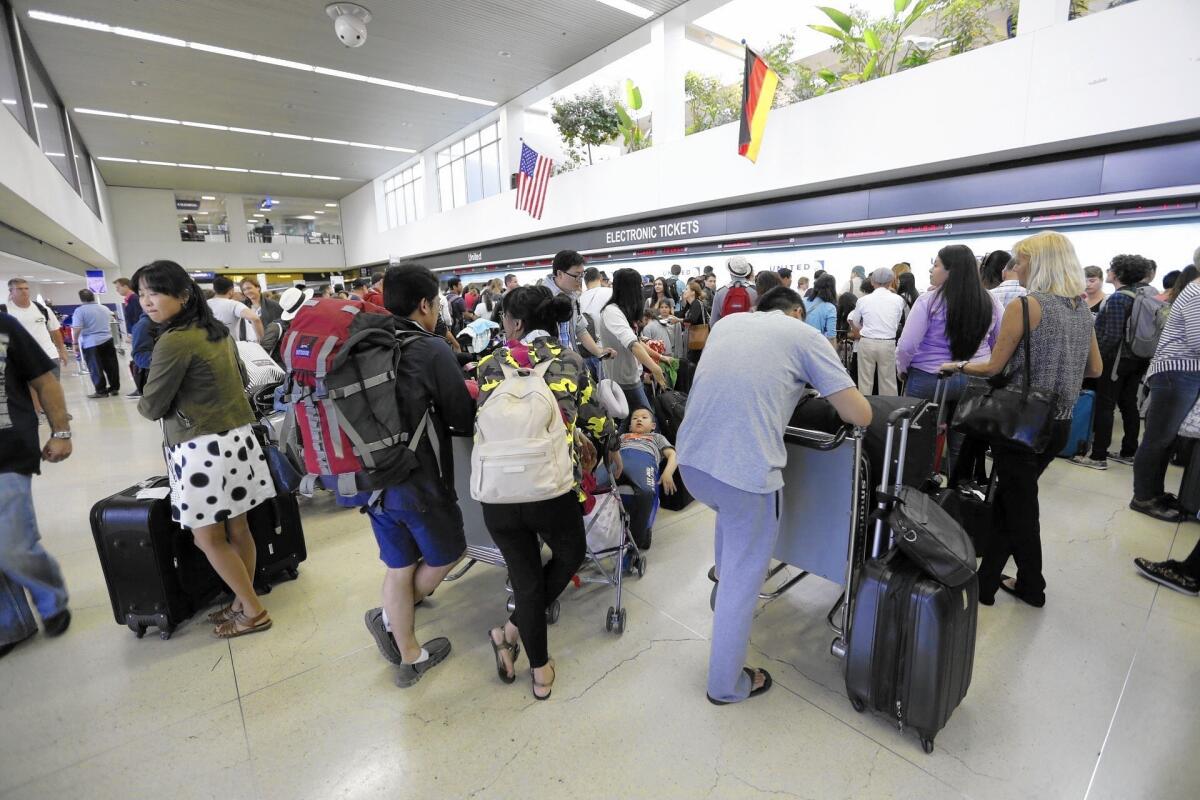LAX could see more than 100 million travelers a year by 2040

New aviation forecasts predict that Los Angeles International Airport, already straining under a record number of passengers, could have more than 100 million travelers annually by 2040, far more than the ceiling set by a 2006 court settlement that will soon expire.
According to projections released last week, the Southern California Assn. of Governments estimates that between 78.9 million and 100.7 million passengers a year will eventually pass through the nationâs second-busiest commercial airport. LAX, the leading international gateway on the West Coast, had 70.7 million passengers last year.
Overall, the regional planning agency predicts that a dozen commercial airports within its six-county jurisdiction will handle between 136 million and 138 million travelers annually by 2040.
The forecast represents at least a 55% increase in air travelers since 2013, but the estimate is significantly less than the prediction of 170 million annual passengers by 2030 that the association made more than a decade ago.
Researchers said the downward revisions stemmed from slowing population growth and events since 9/11 such as sharp increases in fuel costs and the worst economic recession since World War II.
The projections for other major airports in the region indicate that the Burbank Airport will have 6.3 million to 7.3 million passengers a year by 2040; Long Beach 5 million to 6.2 million; LA/Ontario International 7.2 million to 19 million; and John Wayne Airport in Orange County 9.6 million to 13.8 million.
John Wayne, however, has an official cap of 12.5 million annual passengers that expires in 2030.
SCAG is using the new projections to prepare the aviation element of the associationâs 2016-2040 Regional Transportation Plan, which includes airports in Imperial, Los Angeles, Orange, Riverside, San Bernardino and Ventura counties.
Officials said the forecasts could vary between the high and low estimates depending on future planning and policy decisions by local governments, economic conditions, new constraints on airport capacity and population growth.
The associationâs transportation committee discussed the forecasts last week, but declined to adopt them until the panel received additional information from several county and city officials.
Committee members were particularly interested in how long Los Angeles World Airports, which operates LAX, would honor the 2006 court settlement with airport neighbors that set a cap of 78.9 million annual passengers but expires in 2020. The agreement stemmed from a lawsuit challenging the airport redevelopment plan of former Mayor James Hahn.
Airport officials declined to comment in detail about the forecast, but said they would develop LAX in an âenvironmentally friendlyâ manner.
Another meeting to approve the forecasts could be scheduled for as early as Aug. 20.
The 100-million-travelers forecast is important for LAX, which has surpassed its previous record of 67.3 million passengers set in 2000. The growth combined with new airport construction is already causing heavy traffic congestion in the terminal area during peak travel times and has raised concerns that surrounding city streets will become inadequate in the future.
Trips around the terminal area can take up to 30 minutes, and traffic on the westbound 105 Freeway often backs up from the 405 Freeway to Sepulveda Boulevard, one of the main roads to the airport.
âLately, LAX has been handling 70,000 to 80,000 cars a day in the central terminal area. There were 200,000 cars a day on Thanksgiving,â Robert Acherman, vice president of the Alliance for a Regional Solution to Airport Congestion, told the committee. âIf the airport is expanded, every day will be like Thanksgiving Day.â
LAX officials say that congestion will be reduced in the future by proposed modernization projects such as an automated people-mover, a light-rail line to the airport and a transportation center to be used by shuttles and buses that will no longer be allowed to go into the terminal area.
Alliance President Denny Schneider said the growth projections raised questions about the adequacy of the long-standing effort to regionalize air travel, a policy supported by SCAG and required by the 2006 court settlement. Regionalization calls for spreading some of the growth in air traffic away from LAX to other airports in the area.
See the most-read stories this hour >>
Alan Wapner, an Ontario councilman and the transportation committee chairman, noted that the opposite has occurred because LAX has been gaining market share while other airports have lost market share. At his suggestion, the committee overwhelmingly voted in favor of continuing its support for regionalization.
SCAGâs other forecasts show that Oxnard Airport in Ventura County and Imperial County Airport each could have 200,000 annual airline passengers by 2040, while Palmdale Regional Airport, which is now closed, might have up to 1.5 million.
Palm Springs International is expected to have 3 million to 4 million annual passengers. The Southern California Logistics Airport in Victorville is projected to have up to 100,000 airline passengers, and San Bernardino International and the March Inland Port at the March Air Reserve Base each could have up to 200,000 yearly travelers by 2040.
Follow @LADeadline16 on Twitter for transportation and aviation news.
ALSO:
Carnival reaches settlement over access for disabled passengers
Special Olympics are expected to boost L.A.âs tourism industry
Where to find $20 ski lift tickets next winter: Would you believe Iran?
More to Read
Sign up for Essential California
The most important California stories and recommendations in your inbox every morning.
You may occasionally receive promotional content from the Los Angeles Times.











